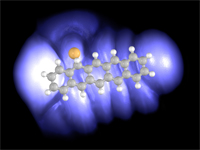Top story
Zurich, Switzerland, 26 May 2006—Researchers at IBM Research - Zurich have succeeded in obtaining direct images of the orbital reorganization that takes place when a gold atom and a pentacene molecule form a complex on a surface. Apart from its scientific beauty, the atomic-scale precision of this single-molecule chemistry experiment breaks new ground in electrical contacting capabilities with individual molecules, which could be of importance for future electronics.

Orbital reorganization upon bond formationAs reported in the May 26 issue of Science, IBM (NYSE: IBM)
scientists Jascha Repp and Gerhard Meyer have succeeded in the single-molecule
synthesis of a complex comprised of a metal and an organic molecule,
in this case gold and pentacene, respectively. They used a scanning
tunneling microscope (STM) to control the synthesis as well as to
characterize the reactants and products of the reaction. They found
that this synthesis is completely reversible and that the gold atom
can be bound to the molecule in different positions. Thus the synthesis
creates different structural isomers — molecules with the same
chemical formula, but in which the atoms are arranged differently
— with different properties. Moreover, because the synthesis
is performed on an insulating surface, namely sodium chloride (NaCl),
the molecular orbitals of the pentacene as well as of the resulting
isomers can be imaged directly using an STM.
Apart from its scientific beauty, the atomic-scale precision of this single-molecule chemistry experiment reaches new heights in electrical contacting capabilities with individual molecules. It demonstrated that it is not only possible to control the atomic-scale geometry of a metal-molecule contact, but also its coupling strength and the phase of the orbital wavefunction at the contact point.
"We can take an image of the molecular orbitals before and after bond formation," explains Jascha Repp, who carried out the experiment, "and thus directly see the changes in shape, energetic position, and occupation of the orbitals upon bond formation. One can take the complex apart again, attach the gold atom in a different position, and have a look at the new orbitals."
Gerhard Meyer, who leads the STM-related efforts at IBM Research - Zurich, says, "In this way, one can — of course, within the general limitations of chemistry — engineer the orbital structure of molecules, and create different kinds of contacts between, in our case, a gold atom and a pentacene molecule."
With the unbroken trend to ever smaller building blocks in future electronics, the amount of control in terms of precise geometry and even of the phase of the electronic wavefunctions, will become a crucial issue. "Eventually chip dimensions might become so small that interference effects will become important," explains Rolf Allenspach, who manages Zurich's research efforts related to the physics of nanoscale systems, "so one needs to understand and exploit such effects."
To investigate the geometrical arrangement and the details of the chemical bond formed, the experimental orbital images have been compared with those calculated using density-functional theory. With the help of these calculations, which were carried out by Sami Paavilainen of the Tampere University of Technology (Finland), Fredrik E. Olsson of the Chalmers University in Göteborg (Sweden) and Mats Persson of the University of Liverpool (UK), the different isomers formed in the experiment could be unambiguously assigned to their corresponding geometrical structures and the nature of the chemical bond could be identified.
The collaboration was conducted within the framework of the European Union (EU) projects "CHIC", "AMMIST", "NANOSPECTRA", and "NANOMAN".
The scientific paper entitled "Imaging Bond Formation Between a Gold Atom and Pentacene on an Insulating Surface" by J. Repp, G. Meyer, S. Paavilainen, F. E. Olsson, and M. Persson was published in Science, Volume 312, Number 5777, pp. 1196-1199 (26 May 2006).